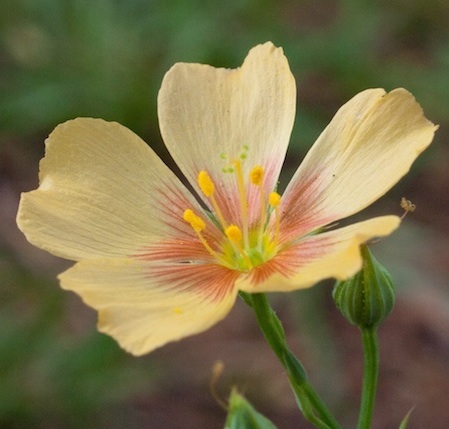Breeding system of Linum rigidum and effect of heterospecific pollen from introduced Euphorbia esula
DOI:
https://doi.org/10.26786/1920-7603(2015)13Abstract
This study investigates the reproductive biology of, and effect of heterospecific pollen from introduced Euphorbia esula on, Linum rigidum, an annual plant native to western and central North America. Breeding-system studies revealed that L. rigidum is self-compatible, with similar pollination success, fruit set and seed set for flowers pollinated with self or outcrossed pollen. Untreated flowers not exposed to pollinators set seed, albeit at a lower rate than hand-pollinated flowers, indicating that L. rigidum can autonomously self pollinate. Experiments investigating whether heterospecific pollen transfer from E. esula interferes with pollination of L. rigidum indicated that large amounts of heterospecific pollen receipt 2 - 4 hours prior to conspecifc pollen receipt reduced fruit and seed production, but that small amounts of heterospecific pollen or larger amounts received immediately prior to conspecific pollen did not affect reproduction. Pollen of E. esula was observed to germinate on and penetrate into L. rigidum stigmas and styles. Nevertheless, Euphorbia esula is unlikely to interfere with L. rigidum’s reproduction because L. rigidum is self-compatible, capable of autonomous self-pollination, and unaffected by receipt of small amounts of Euphorbia pollen.
Downloads
Published
How to Cite
Issue
Section
License
Copyright (c) 2015 Benjamin R Montgomery, Caleb W. Phillips

This work is licensed under a Creative Commons Attribution 4.0 International License.
JPE is an open access journal which means that all content is freely available without charge to the user or his/her institution.
Authors who publish with this journal agree to the following terms:
1) Authors retain copyright and grant the journal right of first publication with the work simultaneously licensed under a Creative Commons Attribution License that allows others to share the work with an acknowledgement of the work's authorship and initial publication in this journal.
2) Authors are able to enter into separate, additional contractual arrangements for the non-exclusive distribution of the journal's published version of the work (e.g., post it to an institutional repository or publish it in a book), with an acknowledgement of its initial publication in this journal.
3) Authors are permitted and encouraged to post their work online (e.g., in institutional repositories or on their website) prior to and during the submission process, as it can lead to productive exchanges, as well as earlier and greater citation of published work (See The Effect of Open Access).
To assure a broader targeted audience, content will be included into databases (such as EBSCO) and directories (such as DOAJ).











